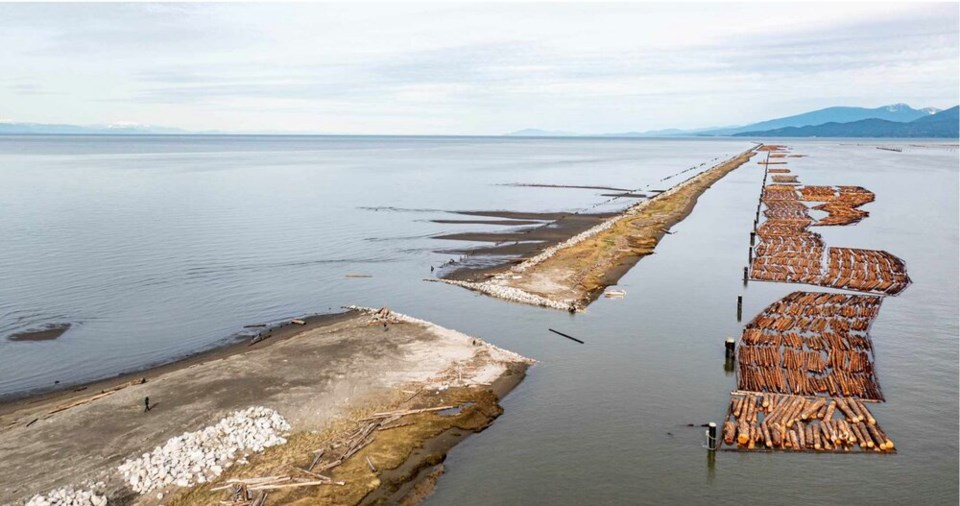For more than 100 years, a seven-kilometre-long jetty has defined the entrance of the North Arm of the Fraser River. Behind it, rafts of logs floated down from inland forests have long been protected from wind and waves.
But what sheltered shipping and the forestry industry meant annihilation for large swathes of salmon habitat — brackish waters where juvenile fish prepare themselves for the transition from fresh water to a life at sea.
“It’s one of the main structures in the Fraser Estuary that reduces connectivity for salmon,” said Dave Scott, a biologist with Raincoast Conservation Foundation and a PhD candidate in the Pacific Salmon Ecology and Conservation Lab at the University of British Columbia.
That is until February 2022, when a collection of environmental groups and the Tsawwassen First Nation punched a 30-metre wide hole in the marine wall.
The project was several years in the making and came after consultations with Transport Canada and Metro Vancouver, who manages public access to the jetty.
Planning included choosing a spot that would still allow people to access a good portion of the jetty, while still leaving it in place for navigation and industry.
“It’s not like we’re just throwing out navigation on the North Arm,” said Scott. “We can make these changes that benefit salmon and it’s not really going to change our lives as humans.”
When a contractor finally barged in heavy equipment to excavate the breach, they had to rush to finish before chinook started to run down the Fraser in late February.
They hit that deadline. Over the next month, Scott and his team went to the site to see how the fish were responding.
They set nets across the breach, and within minutes, started pulling in dozens of chum, pink and chinook salmon.
During each tidal cycle, Scott and his team calculated tens of thousands of fish would use the new opening as a kind of overpass to reach an important section of the Lower Fraser’s brackish estuary.
“We expect to see thousands and thousands of fish moving through our breach each year,” said Scott.
In other words, it appeared to be working.
The Fraser River is Canada’s most important salmon-bearing river but in recent years, it has faced massive declines. Between 1980 and 2014, the Fraser averaged 9.6 million sockeye returns annually, with up to 28 million one year.
By 2020, salmon returning to the Fraser River fell to an all-time record low of 293,000. The 2019 return set the previous low record at 485,000.
In response, last year the federal government announced $647 million in funding to restore Pacific salmon, and in June, it shut roughly 60 per cent of the B.C.’s salmon fishery.
Beyond , salmon face a number of pressures as they live their life at sea, from climate change-driven to changing prey relationships and .
But much of the damage to salmon populations comes from shrinking access to freshwater habitat — whether in upriver spawning grounds or the brackish waters used to acclimate to the ocean.
A released last summer by the University of British Columbia and Raincoast biologists found 85 per cent of the Lower Fraser’s salmon habitat has been lost since the 1850s. From Hope to Delta, a network of culverts, dams, dikes and flood gates prevent salmon migration.
The researchers recommended 1,200 barriers be torn down to undo the worst impacts of city building and agricultural development.
Scott says the breach in the North Arm Jetty represents one small step toward that goal.
“Projects like this are really meant to restore access to habitat that still exists. They just need a little help getting there,” he said. “We can hopefully give them a little better chance of survival.”
Part of the funding for the $550,000 project came from a fine against the University of British Columbia and CIMCO Refrigeration, who in 2019 were fined a combined $2 million after they were found to be responsible for near the university’s Thunderbird Arena.
The toxic substance found its way into the Fraser River where it killed 70 fish.
“We’re really hoping that the benefit of the project will outweigh that damage,” said Scott.
With files from the Canadian Press



